Jianbo Jiao
CoMBO: Conflict Mitigation via Branched Optimization for Class Incremental Segmentation
Apr 05, 2025Abstract:Effective Class Incremental Segmentation (CIS) requires simultaneously mitigating catastrophic forgetting and ensuring sufficient plasticity to integrate new classes. The inherent conflict above often leads to a back-and-forth, which turns the objective into finding the balance between the performance of previous~(old) and incremental~(new) classes. To address this conflict, we introduce a novel approach, Conflict Mitigation via Branched Optimization~(CoMBO). Within this approach, we present the Query Conflict Reduction module, designed to explicitly refine queries for new classes through lightweight, class-specific adapters. This module provides an additional branch for the acquisition of new classes while preserving the original queries for distillation. Moreover, we develop two strategies to further mitigate the conflict following the branched structure, \textit{i.e.}, the Half-Learning Half-Distillation~(HDHL) over classification probabilities, and the Importance-Based Knowledge Distillation~(IKD) over query features. HDHL selectively engages in learning for classification probabilities of queries that match the ground truth of new classes, while aligning unmatched ones to the corresponding old probabilities, thus ensuring retention of old knowledge while absorbing new classes via learning negative samples. Meanwhile, IKD assesses the importance of queries based on their matching degree to old classes, prioritizing the distillation of important features and allowing less critical features to evolve. Extensive experiments in Class Incremental Panoptic and Semantic Segmentation settings have demonstrated the superior performance of CoMBO. Project page: https://guangyu-ryan.github.io/CoMBO.
CL-MVSNet: Unsupervised Multi-view Stereo with Dual-level Contrastive Learning
Mar 11, 2025Abstract:Unsupervised Multi-View Stereo (MVS) methods have achieved promising progress recently. However, previous methods primarily depend on the photometric consistency assumption, which may suffer from two limitations: indistinguishable regions and view-dependent effects, e.g., low-textured areas and reflections. To address these issues, in this paper, we propose a new dual-level contrastive learning approach, named CL-MVSNet. Specifically, our model integrates two contrastive branches into an unsupervised MVS framework to construct additional supervisory signals. On the one hand, we present an image-level contrastive branch to guide the model to acquire more context awareness, thus leading to more complete depth estimation in indistinguishable regions. On the other hand, we exploit a scene-level contrastive branch to boost the representation ability, improving robustness to view-dependent effects. Moreover, to recover more accurate 3D geometry, we introduce an L0.5 photometric consistency loss, which encourages the model to focus more on accurate points while mitigating the gradient penalty of undesirable ones. Extensive experiments on DTU and Tanks&Temples benchmarks demonstrate that our approach achieves state-of-the-art performance among all end-to-end unsupervised MVS frameworks and outperforms its supervised counterpart by a considerable margin without fine-tuning.
MVD-HuGaS: Human Gaussians from a Single Image via 3D Human Multi-view Diffusion Prior
Mar 11, 2025Abstract:3D human reconstruction from a single image is a challenging problem and has been exclusively studied in the literature. Recently, some methods have resorted to diffusion models for guidance, optimizing a 3D representation via Score Distillation Sampling(SDS) or generating one back-view image for facilitating reconstruction. However, these methods tend to produce unsatisfactory artifacts (\textit{e.g.} flattened human structure or over-smoothing results caused by inconsistent priors from multiple views) and struggle with real-world generalization in the wild. In this work, we present \emph{MVD-HuGaS}, enabling free-view 3D human rendering from a single image via a multi-view human diffusion model. We first generate multi-view images from the single reference image with an enhanced multi-view diffusion model, which is well fine-tuned on high-quality 3D human datasets to incorporate 3D geometry priors and human structure priors. To infer accurate camera poses from the sparse generated multi-view images for reconstruction, an alignment module is introduced to facilitate joint optimization of 3D Gaussians and camera poses. Furthermore, we propose a depth-based Facial Distortion Mitigation module to refine the generated facial regions, thereby improving the overall fidelity of the reconstruction.Finally, leveraging the refined multi-view images, along with their accurate camera poses, MVD-HuGaS optimizes the 3D Gaussians of the target human for high-fidelity free-view renderings. Extensive experiments on Thuman2.0 and 2K2K datasets show that the proposed MVD-HuGaS achieves state-of-the-art performance on single-view 3D human rendering.
Surface-SOS: Self-Supervised Object Segmentation via Neural Surface Representation
Jan 17, 2025



Abstract:Self-supervised Object Segmentation (SOS) aims to segment objects without any annotations. Under conditions of multi-camera inputs, the structural, textural and geometrical consistency among each view can be leveraged to achieve fine-grained object segmentation. To make better use of the above information, we propose Surface representation based Self-supervised Object Segmentation (Surface-SOS), a new framework to segment objects for each view by 3D surface representation from multi-view images of a scene. To model high-quality geometry surfaces for complex scenes, we design a novel scene representation scheme, which decomposes the scene into two complementary neural representation modules respectively with a Signed Distance Function (SDF). Moreover, Surface-SOS is able to refine single-view segmentation with multi-view unlabeled images, by introducing coarse segmentation masks as additional input. To the best of our knowledge, Surface-SOS is the first self-supervised approach that leverages neural surface representation to break the dependence on large amounts of annotated data and strong constraints. These constraints typically involve observing target objects against a static background or relying on temporal supervision in videos. Extensive experiments on standard benchmarks including LLFF, CO3D, BlendedMVS, TUM and several real-world scenes show that Surface-SOS always yields finer object masks than its NeRF-based counterparts and surpasses supervised single-view baselines remarkably. Code is available at: https://github.com/zhengxyun/Surface-SOS.
Structure Consistent Gaussian Splatting with Matching Prior for Few-shot Novel View Synthesis
Nov 06, 2024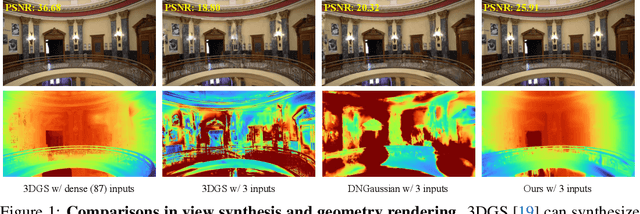



Abstract:Despite the substantial progress of novel view synthesis, existing methods, either based on the Neural Radiance Fields (NeRF) or more recently 3D Gaussian Splatting (3DGS), suffer significant degradation when the input becomes sparse. Numerous efforts have been introduced to alleviate this problem, but they still struggle to synthesize satisfactory results efficiently, especially in the large scene. In this paper, we propose SCGaussian, a Structure Consistent Gaussian Splatting method using matching priors to learn 3D consistent scene structure. Considering the high interdependence of Gaussian attributes, we optimize the scene structure in two folds: rendering geometry and, more importantly, the position of Gaussian primitives, which is hard to be directly constrained in the vanilla 3DGS due to the non-structure property. To achieve this, we present a hybrid Gaussian representation. Besides the ordinary non-structure Gaussian primitives, our model also consists of ray-based Gaussian primitives that are bound to matching rays and whose optimization of their positions is restricted along the ray. Thus, we can utilize the matching correspondence to directly enforce the position of these Gaussian primitives to converge to the surface points where rays intersect. Extensive experiments on forward-facing, surrounding, and complex large scenes show the effectiveness of our approach with state-of-the-art performance and high efficiency. Code is available at https://github.com/prstrive/SCGaussian.
Few Exemplar-Based General Medical Image Segmentation via Domain-Aware Selective Adaptation
Oct 11, 2024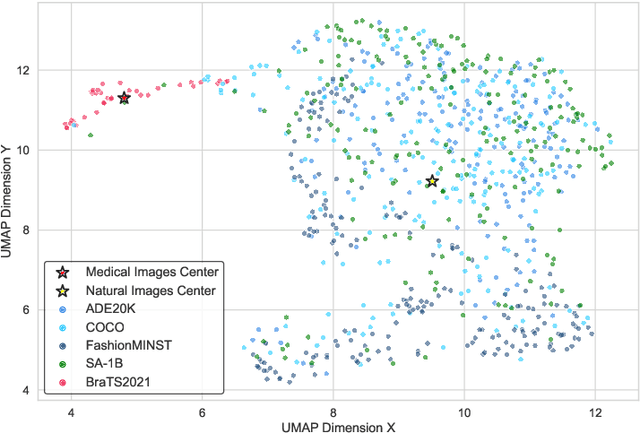
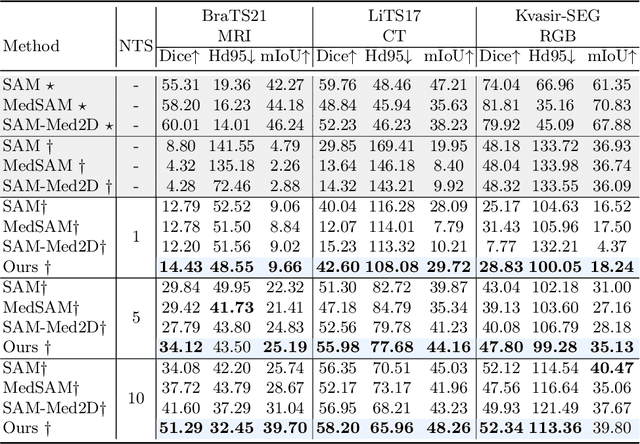
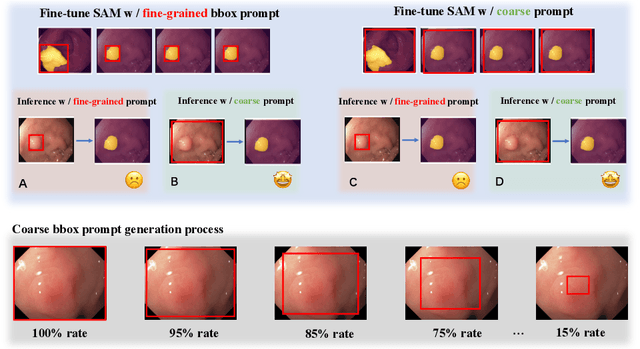

Abstract:Medical image segmentation poses challenges due to domain gaps, data modality variations, and dependency on domain knowledge or experts, especially for low- and middle-income countries (LMICs). Whereas for humans, given a few exemplars (with corresponding labels), we are able to segment different medical images even without exten-sive domain-specific clinical training. In addition, current SAM-based medical segmentation models use fine-grained visual prompts, such as the bounding rectangle generated from manually annotated target segmentation mask, as the bounding box (bbox) prompt during the testing phase. However, in actual clinical scenarios, no such precise prior knowledge is available. Our experimental results also reveal that previous models nearly fail to predict when given coarser bbox prompts. Considering these issues, in this paper, we introduce a domain-aware selective adaptation approach to adapt the general knowledge learned from a large model trained with natural images to the corresponding medical domains/modalities, with access to only a few (e.g. less than 5) exemplars. Our method mitigates the aforementioned limitations, providing an efficient and LMICs-friendly solution. Extensive experimental analysis showcases the effectiveness of our approach, offering potential advancements in healthcare diagnostics and clinical applications in LMICs.
Bridge the Points: Graph-based Few-shot Segment Anything Semantically
Oct 09, 2024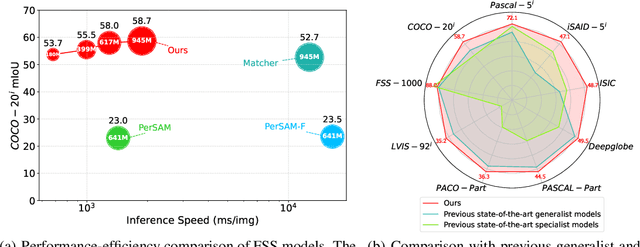
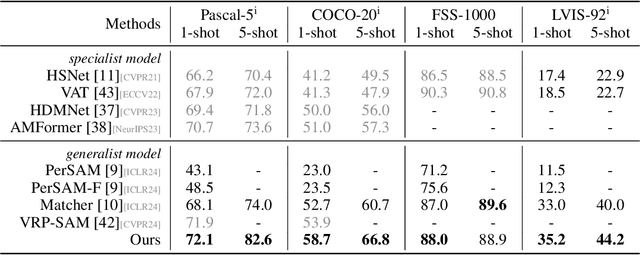
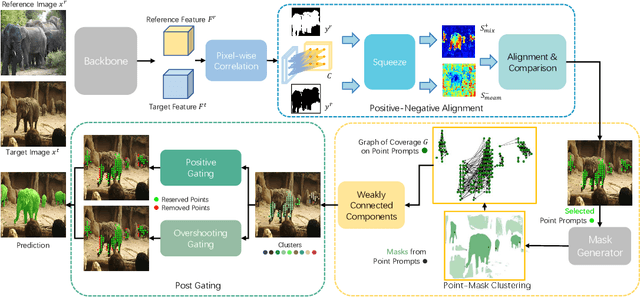
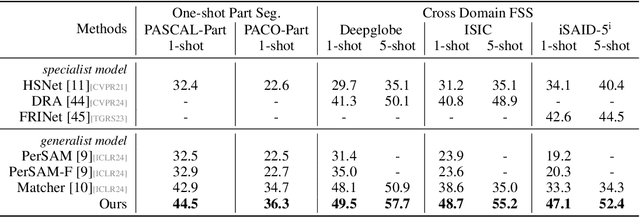
Abstract:The recent advancements in large-scale pre-training techniques have significantly enhanced the capabilities of vision foundation models, notably the Segment Anything Model (SAM), which can generate precise masks based on point and box prompts. Recent studies extend SAM to Few-shot Semantic Segmentation (FSS), focusing on prompt generation for SAM-based automatic semantic segmentation. However, these methods struggle with selecting suitable prompts, require specific hyperparameter settings for different scenarios, and experience prolonged one-shot inference times due to the overuse of SAM, resulting in low efficiency and limited automation ability. To address these issues, we propose a simple yet effective approach based on graph analysis. In particular, a Positive-Negative Alignment module dynamically selects the point prompts for generating masks, especially uncovering the potential of the background context as the negative reference. Another subsequent Point-Mask Clustering module aligns the granularity of masks and selected points as a directed graph, based on mask coverage over points. These points are then aggregated by decomposing the weakly connected components of the directed graph in an efficient manner, constructing distinct natural clusters. Finally, the positive and overshooting gating, benefiting from graph-based granularity alignment, aggregate high-confident masks and filter out the false-positive masks for final prediction, reducing the usage of additional hyperparameters and redundant mask generation. Extensive experimental analysis across standard FSS, One-shot Part Segmentation, and Cross Domain FSS datasets validate the effectiveness and efficiency of the proposed approach, surpassing state-of-the-art generalist models with a mIoU of 58.7% on COCO-20i and 35.2% on LVIS-92i. The code is available in https://andyzaq.github.io/GF-SAM/.
MVPGS: Excavating Multi-view Priors for Gaussian Splatting from Sparse Input Views
Sep 22, 2024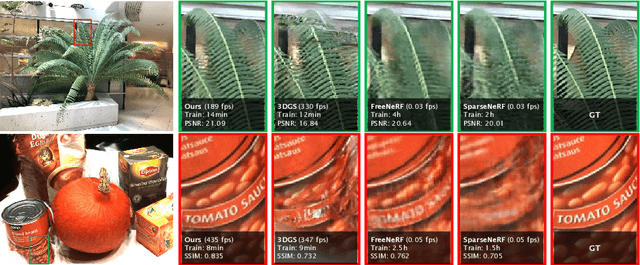
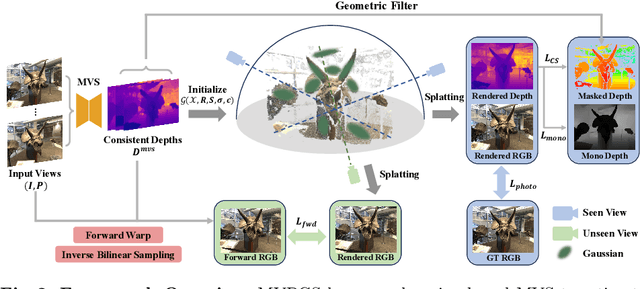

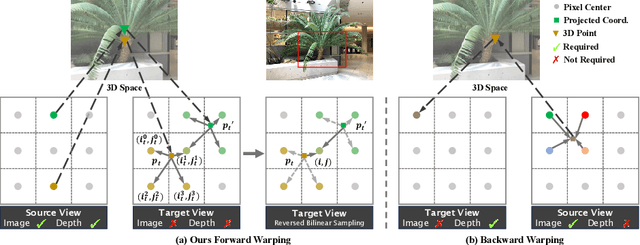
Abstract:Recently, the Neural Radiance Field (NeRF) advancement has facilitated few-shot Novel View Synthesis (NVS), which is a significant challenge in 3D vision applications. Despite numerous attempts to reduce the dense input requirement in NeRF, it still suffers from time-consumed training and rendering processes. More recently, 3D Gaussian Splatting (3DGS) achieves real-time high-quality rendering with an explicit point-based representation. However, similar to NeRF, it tends to overfit the train views for lack of constraints. In this paper, we propose \textbf{MVPGS}, a few-shot NVS method that excavates the multi-view priors based on 3D Gaussian Splatting. We leverage the recent learning-based Multi-view Stereo (MVS) to enhance the quality of geometric initialization for 3DGS. To mitigate overfitting, we propose a forward-warping method for additional appearance constraints conforming to scenes based on the computed geometry. Furthermore, we introduce a view-consistent geometry constraint for Gaussian parameters to facilitate proper optimization convergence and utilize a monocular depth regularization as compensation. Experiments show that the proposed method achieves state-of-the-art performance with real-time rendering speed. Project page: https://zezeaaa.github.io/projects/MVPGS/
Surface-Centric Modeling for High-Fidelity Generalizable Neural Surface Reconstruction
Sep 05, 2024Abstract:Reconstructing the high-fidelity surface from multi-view images, especially sparse images, is a critical and practical task that has attracted widespread attention in recent years. However, existing methods are impeded by the memory constraint or the requirement of ground-truth depths and cannot recover satisfactory geometric details. To this end, we propose SuRF, a new Surface-centric framework that incorporates a new Region sparsification based on a matching Field, achieving good trade-offs between performance, efficiency and scalability. To our knowledge, this is the first unsupervised method achieving end-to-end sparsification powered by the introduced matching field, which leverages the weight distribution to efficiently locate the boundary regions containing surface. Instead of predicting an SDF value for each voxel, we present a new region sparsification approach to sparse the volume by judging whether the voxel is inside the surface region. In this way, our model can exploit higher frequency features around the surface with less memory and computational consumption. Extensive experiments on multiple benchmarks containing complex large-scale scenes show that our reconstructions exhibit high-quality details and achieve new state-of-the-art performance, i.e., 46% improvements with 80% less memory consumption. Code is available at https://github.com/prstrive/SuRF.
Frame Interpolation with Consecutive Brownian Bridge Diffusion
May 09, 2024



Abstract:Recent work in Video Frame Interpolation (VFI) tries to formulate VFI as a diffusion-based conditional image generation problem, synthesizing the intermediate frame given a random noise and neighboring frames. Due to the relatively high resolution of videos, Latent Diffusion Models (LDMs) are employed as the conditional generation model, where the autoencoder compresses images into latent representations for diffusion and then reconstructs images from these latent representations. Such a formulation poses a crucial challenge: VFI expects that the output is deterministically equal to the ground truth intermediate frame, but LDMs randomly generate a diverse set of different images when the model runs multiple times. The reason for the diverse generation is that the cumulative variance (variance accumulated at each step of generation) of generated latent representations in LDMs is large. This makes the sampling trajectory random, resulting in diverse rather than deterministic generations. To address this problem, we propose our unique solution: Frame Interpolation with Consecutive Brownian Bridge Diffusion. Specifically, we propose consecutive Brownian Bridge diffusion that takes a deterministic initial value as input, resulting in a much smaller cumulative variance of generated latent representations. Our experiments suggest that our method can improve together with the improvement of the autoencoder and achieve state-of-the-art performance in VFI, leaving strong potential for further enhancement.
 Add to Chrome
Add to Chrome Add to Firefox
Add to Firefox Add to Edge
Add to Edge